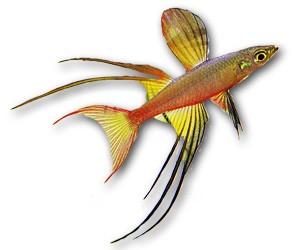Threadfin Rainbow

Quick Stats
| Size | Up to 2" (5cm) |
|---|---|
| Tank | 80 Litres for a small shoal |
| Swimming Area | Middle, top |
| Ph | 6.5 to 7.5 |
| Temperature | 75ºF to 82ºF (23 - 28°C) |
| Food | Flaked, live or frozen |
Common Name:
Threadfin Rainbow.
Distribution:
Central and southern New Guinea, northern Australia.
Colouration:
Bodies are thin, silver and have faded vertical stripes. The bodily fins are all black-based with red/tan overlay. Caudal fins are transparent with red tips and are largely bifurcated. (Females have a pink, not red, tip to their caudal fin.)
Lifespan:
3 to 5 Years.
Maintenance:
10 to 20% weekly. An easy fish to care for, the tank need not be large. They are a schooling fish and should be kept in groups, being peaceful they can be housed with other community type fish. Their long fins are easy targets for fin-nippers; species tanks are the recommended homes for these fish anyway as they don't breed well with the company of other species.
Feeding:
They need smaller foods than most fishes as they have a throat with a comparatively small diameter. They are omnivorous, so they'll take live foods and standard foods for tropical community fishes.
Substrate:
Not critical. Sand is easier to maintain.
Tank Decor:
The tank can be small and heavily decorated with live plants. Plants make them feel secure and therefore they will show their colours better. Its not important if plants are artificial or real.
Filtration:
Standard filtration for the size of the tank.
Biotype:
They live in swamps and the slow-moving thickly vegetated areas of streams and other flowing waters.
Sexing
It's all about the fins. Males will have larger, gaudier finnage than their female counterparts. They'll also have more intense colours than the females.
Breeding:
Unlike many hardier rainbows, they can't be counted upon to breed themselves. Near-immaculate conditions, a slight cooling and a decent-sized water change may induce spawning behaviours. Males start the spawning process by displaying to the females and the spawning almost always takes place in the morning (though you can likely affect the time of spawning by changing the times at which the fish room is light). These fish will likely have eggs attached to plants. They may be induced to use a spawning mop but there is no guarantee that they would choose that over other plants in the tank. Microencapsulated fry foods are good starter foods, as are microworms. Anything much larger can and may cause serious damage to a fish whose mouth is large but throat is not.